Canidlover
and I are planning a trip to CoCoView in Roatàn from early- to mid-July. We think that this place is Paradise, and this will be our third trip in as many years. You can learn more about CoCoView on Mr. Scuba's other page.
I travel with a group of divers from the Midwest, one of whom is a Marine Biologist working for the Shedd Aquarium in Chicago, IL. He really knows his stuff, and has lived and traveled around the Pacific Ocean.
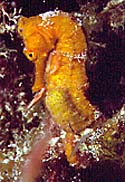 Last summer I spent a week diving the Great Barrier Reef from the Australian Museum's research station on Lizard Island, and a week in the tropical rainforest of Northern Queensland.
Last summer I spent a week diving the Great Barrier Reef from the Australian Museum's research station on Lizard Island, and a week in the tropical rainforest of Northern Queensland.
The trip to Lizard Island was long - 33 hours from Chicago including layovers - and that was the only negative thing about the trip! The climate of the island was temperate; water was about 75°F and in the lagoon (back reef) 30-feet maximum depth. We were pulling 60- to 80-minute dive times and diving on the average twice per day. On the fore reef, we could go as deep as we wished.
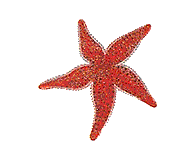
The tides are of the mixed type, with two highs and lows in 24 hours. (Sometimes that meant that the difference between the day's high and low tide was small, othertimes it was great.) Some days there were six-foot tides, some days the tide was about one foot, which made boat anchoring interesting, let me tell you! When that much water is pulled/pushed into/out of a lagoon, there will be a lot of particles in the water, except for the few hours of slack tide, but it may or may not be feasible to dive at that time. There is an almost constant westerly wind; however, there are many sheltered coves around the island with great beaches for waiting out surface intervals.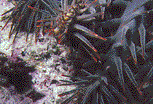 The worst visibility was still good, but never as clear as what I experienced at Cod Hole on Ribbon Reef #10. That was a good haul from the Island, too far for our small (15') dive boats. A charter dive boat does go out there a couple of times a week, and it is only a day-long trip, well worth whatever it costs you to do that dive!
The worst visibility was still good, but never as clear as what I experienced at Cod Hole on Ribbon Reef #10. That was a good haul from the Island, too far for our small (15') dive boats. A charter dive boat does go out there a couple of times a week, and it is only a day-long trip, well worth whatever it costs you to do that dive!
 On Lizard Island are monitor lizards; the locals refer to them as "Goanas", and they are related to the Komodo dragon. There ae also birds and flying foxes (fruit bats) on this island, which is a granite (volcanic) portion that drifted off the mainland about 10 miles away (the mountains are still visible over the horizon)..
On Lizard Island are monitor lizards; the locals refer to them as "Goanas", and they are related to the Komodo dragon. There ae also birds and flying foxes (fruit bats) on this island, which is a granite (volcanic) portion that drifted off the mainland about 10 miles away (the mountains are still visible over the horizon)..
 We did not stay at Quantas' Lizard Island Resort on the northwest end, but at the Research Station run by the Australian Museum on the southwest side. We were part of a group of 11 college students studying coral reef ecology. As such, we filled our own tanks, captained/crew our own boats. Going out in a small boat was never a problem, but coming back from the north into the wind made for a very bumpy ride home.
We did not stay at Quantas' Lizard Island Resort on the northwest end, but at the Research Station run by the Australian Museum on the southwest side. We were part of a group of 11 college students studying coral reef ecology. As such, we filled our own tanks, captained/crew our own boats. Going out in a small boat was never a problem, but coming back from the north into the wind made for a very bumpy ride home.


The abundance of marine life and variety of species just blew me away! I had wanted to dive the far Pacific for 20 years, and had a life list of marine animals I wanted to see. I would have considered the trip worth while to have seen only one Tridachna clam, one Lionfish, one Clown anemonefish, one Picasso triggerfish, one Unicornfish and one Crown-of-thorns starfish. Instead, I saw literally dozens of each in a variety of species. My companion does not dive, yet with the exception of the Potato Cod and Maori Wrasse, she saw almost everything that I did and in only five to 20 feet of water, to boot. The only fish none of us saw was the Clown triggerfish - guess we'll have to go back!!
 After a week of intensive diving and oceanography, our group headed for the mainland and split up. Some of the younger travelers went directly home, while others like Canidlover
and I stayed a bit longer to see more of Australia. We found the Australians to be a friendly lot, and English is the official spoken language, which is a plus for monolingual types like me. The currency is dollars, which made it easier to compute the value of things (though $1 and $2 are small brass coins). At the time we went, $100 US=$131 AU and businesses didn't really want to accept greenbacks or travelers' checks.
After a week of intensive diving and oceanography, our group headed for the mainland and split up. Some of the younger travelers went directly home, while others like Canidlover
and I stayed a bit longer to see more of Australia. We found the Australians to be a friendly lot, and English is the official spoken language, which is a plus for monolingual types like me. The currency is dollars, which made it easier to compute the value of things (though $1 and $2 are small brass coins). At the time we went, $100 US=$131 AU and businesses didn't really want to accept greenbacks or travelers' checks.
(HOT TIP!! Use your TYME or electronic banking card to draw spending money - you can get a list of machine locations from your bank before you leave home. That way you don't pay a fee for travelers' checks and lose value each time you convert them to or from AU$.)
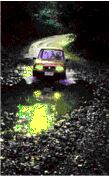 If you visit Cairns and can take the time, rent a four-wheel drive vehicle and go up the Bloomfield Track into the rainforest. North of the Daintree River travel without a FWD vehicle is not recommended, although the road is not too bad up as far as Cape Tribulation. At some places, there are paved sections, wooden bridges, and cement strips to help cars without FWD up and over the hill. At Cape Tribulation the "road" ends, and from there to Georgetown you are driving over the Bloomfield Track - an old logging road through the jungle and over mountains! The road runs through the Wet Tropics World Wildlife Heritage Area and is as "natural" as possible. There are no bridges - just fords across the creeks with high water marks to let you know just how deep the water may be, and there are plenty of tributaries that run down from the billabongs up in the rainforest and empty into the ocean. There was a bridge at Bloomfield, where there was an actual river to cross but the center span had washed out and the middle was filled with rubble.
If you visit Cairns and can take the time, rent a four-wheel drive vehicle and go up the Bloomfield Track into the rainforest. North of the Daintree River travel without a FWD vehicle is not recommended, although the road is not too bad up as far as Cape Tribulation. At some places, there are paved sections, wooden bridges, and cement strips to help cars without FWD up and over the hill. At Cape Tribulation the "road" ends, and from there to Georgetown you are driving over the Bloomfield Track - an old logging road through the jungle and over mountains! The road runs through the Wet Tropics World Wildlife Heritage Area and is as "natural" as possible. There are no bridges - just fords across the creeks with high water marks to let you know just how deep the water may be, and there are plenty of tributaries that run down from the billabongs up in the rainforest and empty into the ocean. There was a bridge at Bloomfield, where there was an actual river to cross but the center span had washed out and the middle was filled with rubble.
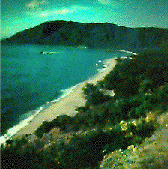 We traveled along the Bloomfield Track through the Findlayson Range as far as the Lion's Head Pub billed as the oldest pub in Australia. We had a great lunch while talking with some pig hunters about their life and work. These people make some extra cash using specially-trained and
-equipped dogs to locate and capture feral pigs (whose ancestors originated as escapees from Captain Cook's stranding in 1770), then selling them in Georgetown whence they are transported to the Philippines and other parts of Asia for market.
We wanted to continue on to Georgetown but no one could agree on just how much longer that trip would take. Apparently it is quite hard to calculate the speed at which a novice off-roader like myself could travel a known distance. I did not much relish the idea of camping in the rainforest that night, and since we had a reservation at a lovely resort back at Cape Tribulation we never did get to see Georgetown. Oh well, save something for next time!
We traveled along the Bloomfield Track through the Findlayson Range as far as the Lion's Head Pub billed as the oldest pub in Australia. We had a great lunch while talking with some pig hunters about their life and work. These people make some extra cash using specially-trained and
-equipped dogs to locate and capture feral pigs (whose ancestors originated as escapees from Captain Cook's stranding in 1770), then selling them in Georgetown whence they are transported to the Philippines and other parts of Asia for market.
We wanted to continue on to Georgetown but no one could agree on just how much longer that trip would take. Apparently it is quite hard to calculate the speed at which a novice off-roader like myself could travel a known distance. I did not much relish the idea of camping in the rainforest that night, and since we had a reservation at a lovely resort back at Cape Tribulation we never did get to see Georgetown. Oh well, save something for next time!
The experience of staying in the rainforest is unique, with creatures showing up at night just outside our villa, which may have a large screened window or perhaps a deck that faces or overlooks the rainforest. We put our dive lights to good use tramping through the rainforest on a 'night safari' with several other guests making enough noise to wake the dead, and not seeing much. Later we observed some Forest Dragons, and Tree Possums as well as other nocturnal animals right from the comfort of our villa. To give you an idea of some of the scenery, several secens of the new of "The Island of Dr. Moreau" were filmed near where we stayed; in fact, the week after we left the Coconut Beach Reef Resort it was completely booked up by the production company.
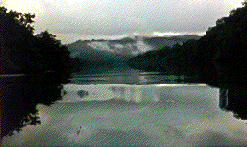 Another activity we recommend if you have an interest in learning more about the local fauna, is to go on an early-morning bird-watching tour with ornithologist Chris Dahlberg. he takes only one small boatload of ten people up the Daintree River at sunrise. When we went with him, we were among the fortunate few to see the nesting site and fledgling of the Australian Great Billed Heron. Mr. Dahlberg told us that though the species had been known for over 180 years, he was the first person to observe the courtship and nesting of these birds! All in all, we saw over 135 different types of birds on that trip. Mrs. Dahlberg operates a rescue program for damaged or injured Flying Foxes, a species of Australian fruit bat.
Another activity we recommend if you have an interest in learning more about the local fauna, is to go on an early-morning bird-watching tour with ornithologist Chris Dahlberg. he takes only one small boatload of ten people up the Daintree River at sunrise. When we went with him, we were among the fortunate few to see the nesting site and fledgling of the Australian Great Billed Heron. Mr. Dahlberg told us that though the species had been known for over 180 years, he was the first person to observe the courtship and nesting of these birds! All in all, we saw over 135 different types of birds on that trip. Mrs. Dahlberg operates a rescue program for damaged or injured Flying Foxes, a species of Australian fruit bat.
We found the accommodations in Far Northern Queensland to be small and independently owned/operated, which makes for a much friendlier experience, and everything was clean and in good repair, size not being an indicator of top-drawer service. (No chain hotels, or restaurants more than 24 miles north of Cairns .) The area reminded me very much of the type of Northern Wisconsin resorts I visited with my family as a young boy.
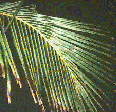 Two places we highly recommend are Coconut Beach Rainforest Resort near Cape Tribulation where the rainforest does indeed meet the reef, and Silky Oaks Lodge on the edge of the Mossman Gorge just north of Port Douglas. BTW:Both of these resorts have received top honors from the Queensland division of the Australian Tourism Board within the past two years! Overall, it was a unique experience - one that I'm afraid can't last forever.
Two places we highly recommend are Coconut Beach Rainforest Resort near Cape Tribulation where the rainforest does indeed meet the reef, and Silky Oaks Lodge on the edge of the Mossman Gorge just north of Port Douglas. BTW:Both of these resorts have received top honors from the Queensland division of the Australian Tourism Board within the past two years! Overall, it was a unique experience - one that I'm afraid can't last forever.
If there are other specific things you wish to know

 This page contains transparent graphics and animated GIFs which are guaranteed to work on Netscape Browsers. If you don't have Netscape 2.0, the GIFs will be stationary. Click the button to download!
This page contains transparent graphics and animated GIFs which are guaranteed to work on Netscape Browsers. If you don't have Netscape 2.0, the GIFs will be stationary. Click the button to download!
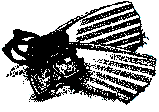
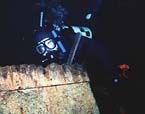 I enjoy all kinds of diving, and I have done my share of wreck, cold, deep, drift, and even mine diving (that's right - underground or "deep earth" as Bonne Terre Mine in Missouri describes it) in both fresh and saltwater. As a member of the >40 club (years as well as dives), I now do most of my diving in warm water, hence my home page location here in TheTropics.
I enjoy all kinds of diving, and I have done my share of wreck, cold, deep, drift, and even mine diving (that's right - underground or "deep earth" as Bonne Terre Mine in Missouri describes it) in both fresh and saltwater. As a member of the >40 club (years as well as dives), I now do most of my diving in warm water, hence my home page location here in TheTropics.

 Last summer I spent a week diving the Great Barrier Reef from the Australian Museum's research station on Lizard Island, and a week in the tropical rainforest of Northern Queensland.
Last summer I spent a week diving the Great Barrier Reef from the Australian Museum's research station on Lizard Island, and a week in the tropical rainforest of Northern Queensland.

 The worst visibility was still good, but never as clear as what I experienced at Cod Hole on Ribbon Reef #10. That was a good haul from the Island, too far for our small (15') dive boats. A charter dive boat does go out there a couple of times a week, and it is only a day-long trip, well worth whatever it costs you to do that dive!
The worst visibility was still good, but never as clear as what I experienced at Cod Hole on Ribbon Reef #10. That was a good haul from the Island, too far for our small (15') dive boats. A charter dive boat does go out there a couple of times a week, and it is only a day-long trip, well worth whatever it costs you to do that dive!
 On Lizard Island are monitor lizards; the locals refer to them as "Goanas", and they are related to the Komodo dragon. There ae also birds and flying foxes (fruit bats) on this island, which is a granite (volcanic) portion that drifted off the mainland about 10 miles away (the mountains are still visible over the horizon)..
On Lizard Island are monitor lizards; the locals refer to them as "Goanas", and they are related to the Komodo dragon. There ae also birds and flying foxes (fruit bats) on this island, which is a granite (volcanic) portion that drifted off the mainland about 10 miles away (the mountains are still visible over the horizon)..
 We did not stay at Quantas' Lizard Island Resort on the northwest end, but at the Research Station run by the Australian Museum on the southwest side. We were part of a group of 11 college students studying coral reef ecology. As such, we filled our own tanks, captained/crew our own boats. Going out in a small boat was never a problem, but coming back from the north into the wind made for a very bumpy ride home.
We did not stay at Quantas' Lizard Island Resort on the northwest end, but at the Research Station run by the Australian Museum on the southwest side. We were part of a group of 11 college students studying coral reef ecology. As such, we filled our own tanks, captained/crew our own boats. Going out in a small boat was never a problem, but coming back from the north into the wind made for a very bumpy ride home.


 After a week of intensive diving and oceanography, our group headed for the mainland and split up. Some of the younger travelers went directly home, while others like
After a week of intensive diving and oceanography, our group headed for the mainland and split up. Some of the younger travelers went directly home, while others like  If you visit Cairns and can take the time, rent a four-wheel drive vehicle and go up the Bloomfield Track into the rainforest. North of the Daintree River travel without a FWD vehicle is not recommended, although the road is not too bad up as far as Cape Tribulation. At some places, there are paved sections, wooden bridges, and cement strips to help cars without FWD up and over the hill. At Cape Tribulation the "road" ends, and from there to Georgetown you are driving over the Bloomfield Track - an old logging road through the jungle and over mountains! The road runs through the Wet Tropics World Wildlife Heritage Area and is as "natural" as possible. There are no bridges - just fords across the creeks with high water marks to let you know just how deep the water may be, and there are plenty of tributaries that run down from the billabongs up in the rainforest and empty into the ocean. There was a bridge at Bloomfield, where there was an actual river to cross but the center span had washed out and the middle was filled with rubble.
If you visit Cairns and can take the time, rent a four-wheel drive vehicle and go up the Bloomfield Track into the rainforest. North of the Daintree River travel without a FWD vehicle is not recommended, although the road is not too bad up as far as Cape Tribulation. At some places, there are paved sections, wooden bridges, and cement strips to help cars without FWD up and over the hill. At Cape Tribulation the "road" ends, and from there to Georgetown you are driving over the Bloomfield Track - an old logging road through the jungle and over mountains! The road runs through the Wet Tropics World Wildlife Heritage Area and is as "natural" as possible. There are no bridges - just fords across the creeks with high water marks to let you know just how deep the water may be, and there are plenty of tributaries that run down from the billabongs up in the rainforest and empty into the ocean. There was a bridge at Bloomfield, where there was an actual river to cross but the center span had washed out and the middle was filled with rubble.
 We traveled along the Bloomfield Track through the Findlayson Range as far as the Lion's Head Pub billed as the oldest pub in Australia. We had a great lunch while talking with some pig hunters about their life and work. These people make some extra cash using specially-trained and
-equipped dogs to locate and capture feral pigs (whose ancestors originated as escapees from Captain Cook's stranding in 1770), then selling them in Georgetown whence they are transported to the Philippines and other parts of Asia for market.
We wanted to continue on to Georgetown but no one could agree on just how much longer that trip would take. Apparently it is quite hard to calculate the speed at which a novice off-roader like myself could travel a known distance. I did not much relish the idea of camping in the rainforest that night, and since we had a reservation at a lovely resort back at Cape Tribulation we never did get to see Georgetown. Oh well, save something for next time!
We traveled along the Bloomfield Track through the Findlayson Range as far as the Lion's Head Pub billed as the oldest pub in Australia. We had a great lunch while talking with some pig hunters about their life and work. These people make some extra cash using specially-trained and
-equipped dogs to locate and capture feral pigs (whose ancestors originated as escapees from Captain Cook's stranding in 1770), then selling them in Georgetown whence they are transported to the Philippines and other parts of Asia for market.
We wanted to continue on to Georgetown but no one could agree on just how much longer that trip would take. Apparently it is quite hard to calculate the speed at which a novice off-roader like myself could travel a known distance. I did not much relish the idea of camping in the rainforest that night, and since we had a reservation at a lovely resort back at Cape Tribulation we never did get to see Georgetown. Oh well, save something for next time!
 Another activity we recommend if you have an interest in learning more about the local fauna, is to go on an early-morning bird-watching tour with ornithologist Chris Dahlberg. he takes only one small boatload of ten people up the Daintree River at sunrise. When we went with him, we were among the fortunate few to see the nesting site and fledgling of the Australian Great Billed Heron. Mr. Dahlberg told us that though the species had been known for over 180 years, he was the first person to observe the courtship and nesting of these birds! All in all, we saw over 135 different types of birds on that trip. Mrs. Dahlberg operates a rescue program for damaged or injured Flying Foxes, a species of Australian fruit bat.
Another activity we recommend if you have an interest in learning more about the local fauna, is to go on an early-morning bird-watching tour with ornithologist Chris Dahlberg. he takes only one small boatload of ten people up the Daintree River at sunrise. When we went with him, we were among the fortunate few to see the nesting site and fledgling of the Australian Great Billed Heron. Mr. Dahlberg told us that though the species had been known for over 180 years, he was the first person to observe the courtship and nesting of these birds! All in all, we saw over 135 different types of birds on that trip. Mrs. Dahlberg operates a rescue program for damaged or injured Flying Foxes, a species of Australian fruit bat.
 Two places we highly recommend are Coconut Beach Rainforest Resort near Cape Tribulation where the rainforest does indeed meet the reef, and Silky Oaks Lodge on the edge of the Mossman Gorge just north of Port Douglas. BTW:Both of these resorts have received top honors from the Queensland division of the Australian Tourism Board within the past two years! Overall, it was a unique experience - one that I'm afraid can't last forever.
Two places we highly recommend are Coconut Beach Rainforest Resort near Cape Tribulation where the rainforest does indeed meet the reef, and Silky Oaks Lodge on the edge of the Mossman Gorge just north of Port Douglas. BTW:Both of these resorts have received top honors from the Queensland division of the Australian Tourism Board within the past two years! Overall, it was a unique experience - one that I'm afraid can't last forever.
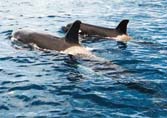 After diving the Great Barrier Reef, one of the members of our group traveled on to Agnes Lodge on Munda where he had a very unusual experience. During the first week of August, while taking a surface interval on the beach between dives, he noticed a pod of dolphins swimming through the lagoon, immediately followed by some Orca whales. The divemaster asked if anyone wanted to snorkel with Orcas. The group responded with a resounding Yes!, so they all loaded up and motored over to where three large Orcas were frolicking in the water. My buddy got in the water and the Orcas came within arm's-length of him. He took pictures and some of them show only large areas of black, because he couldn't get far enough away to get a better picture! Everyone was impressed with the size of these three Orcas, when all of a sudden an even larger Orca arrived on the scene. My buddy watched this Orca grab a 300-pound, six-foot-long dolphin in its mouth and head for the bottom.
After diving the Great Barrier Reef, one of the members of our group traveled on to Agnes Lodge on Munda where he had a very unusual experience. During the first week of August, while taking a surface interval on the beach between dives, he noticed a pod of dolphins swimming through the lagoon, immediately followed by some Orca whales. The divemaster asked if anyone wanted to snorkel with Orcas. The group responded with a resounding Yes!, so they all loaded up and motored over to where three large Orcas were frolicking in the water. My buddy got in the water and the Orcas came within arm's-length of him. He took pictures and some of them show only large areas of black, because he couldn't get far enough away to get a better picture! Everyone was impressed with the size of these three Orcas, when all of a sudden an even larger Orca arrived on the scene. My buddy watched this Orca grab a 300-pound, six-foot-long dolphin in its mouth and head for the bottom.
 The divemaster explained that the Orcas had been hunting. This was the male, and the other Orcas were part of his pod. He blocked one exit of the lagoon, and the other three drove the dolphins into the lagoon; the dolphins couldn't get out and it was now lunch time for the Orcas. While there is no known record of a human ever being attacked by an Orca, the divemaster called an end to the snorkel because he was afraid the blood in the water would draw sharks.
The divemaster explained that the Orcas had been hunting. This was the male, and the other Orcas were part of his pod. He blocked one exit of the lagoon, and the other three drove the dolphins into the lagoon; the dolphins couldn't get out and it was now lunch time for the Orcas. While there is no known record of a human ever being attacked by an Orca, the divemaster called an end to the snorkel because he was afraid the blood in the water would draw sharks.

 Click here to go to Mr. Scuba's other place
Click here to go to Mr. Scuba's other place Links to other dive related sites on the Web
Links to other dive related sites on the Web



 Return to
Return to